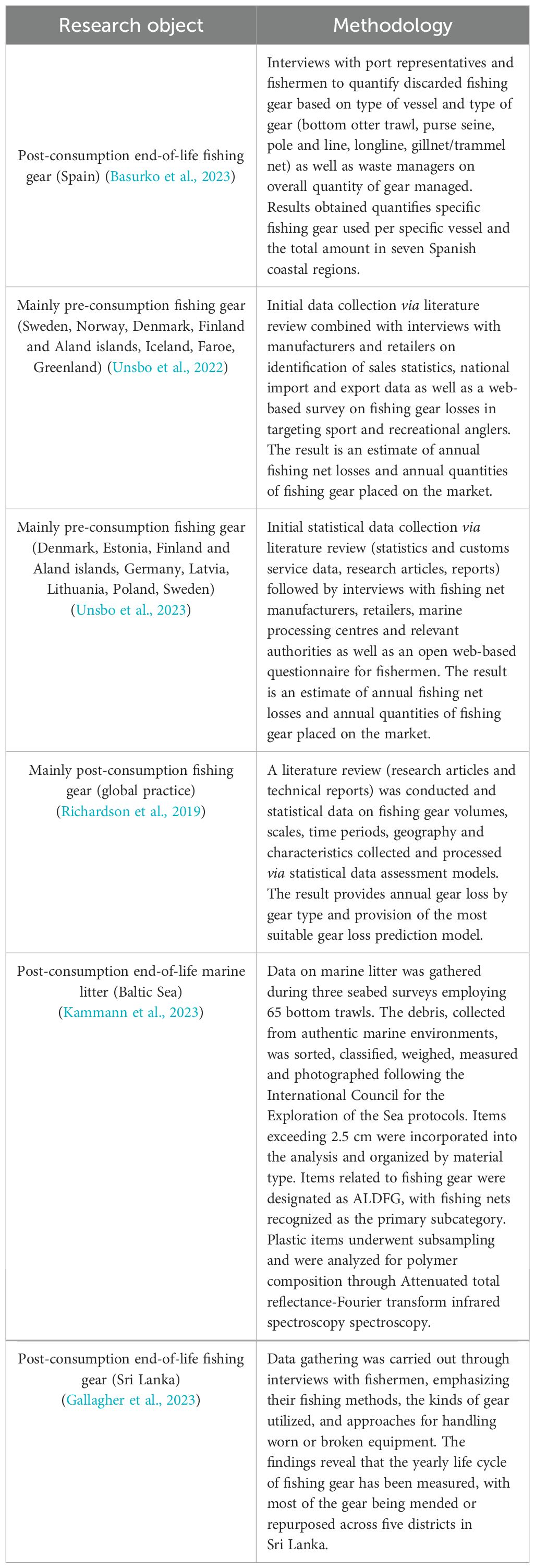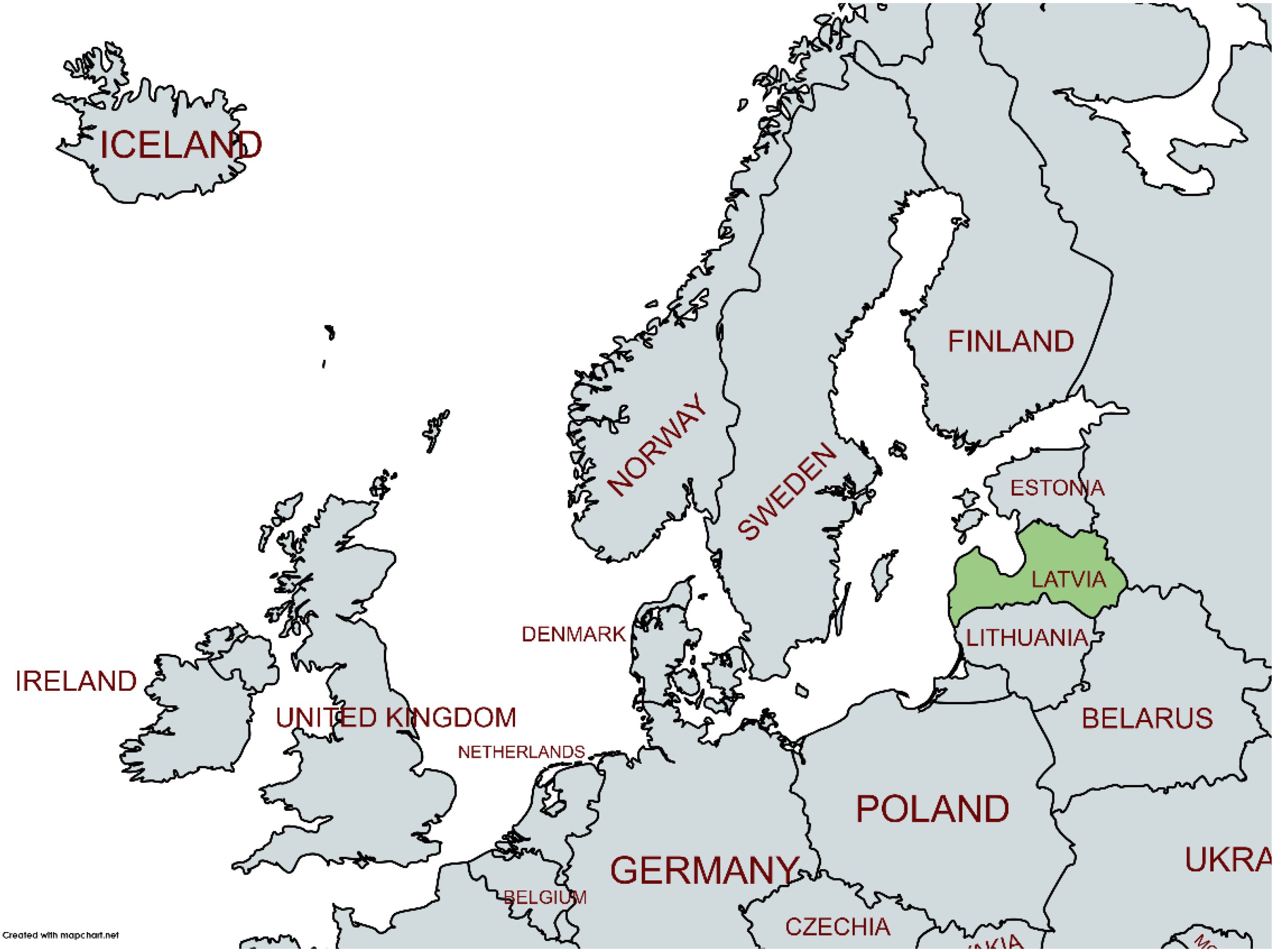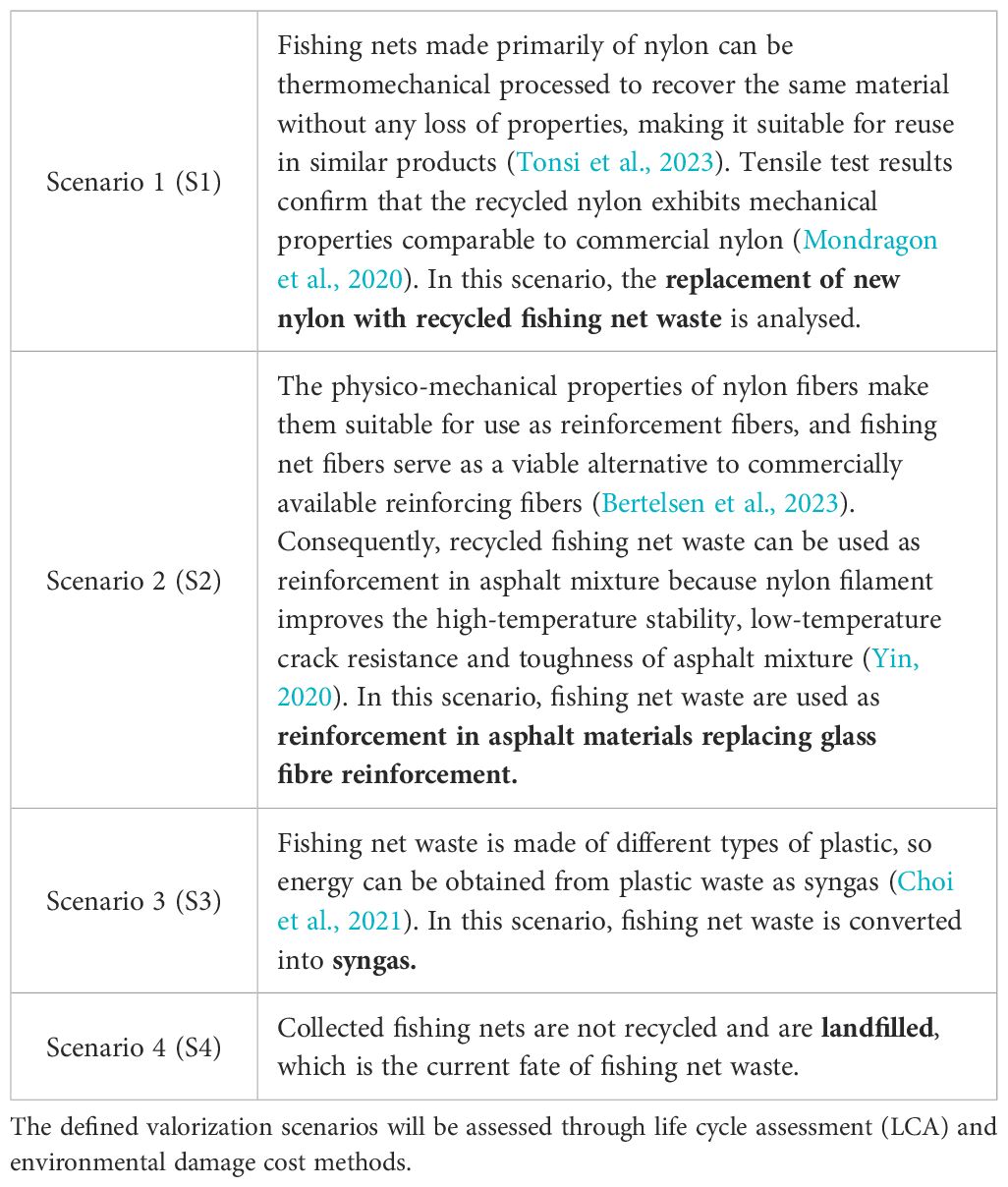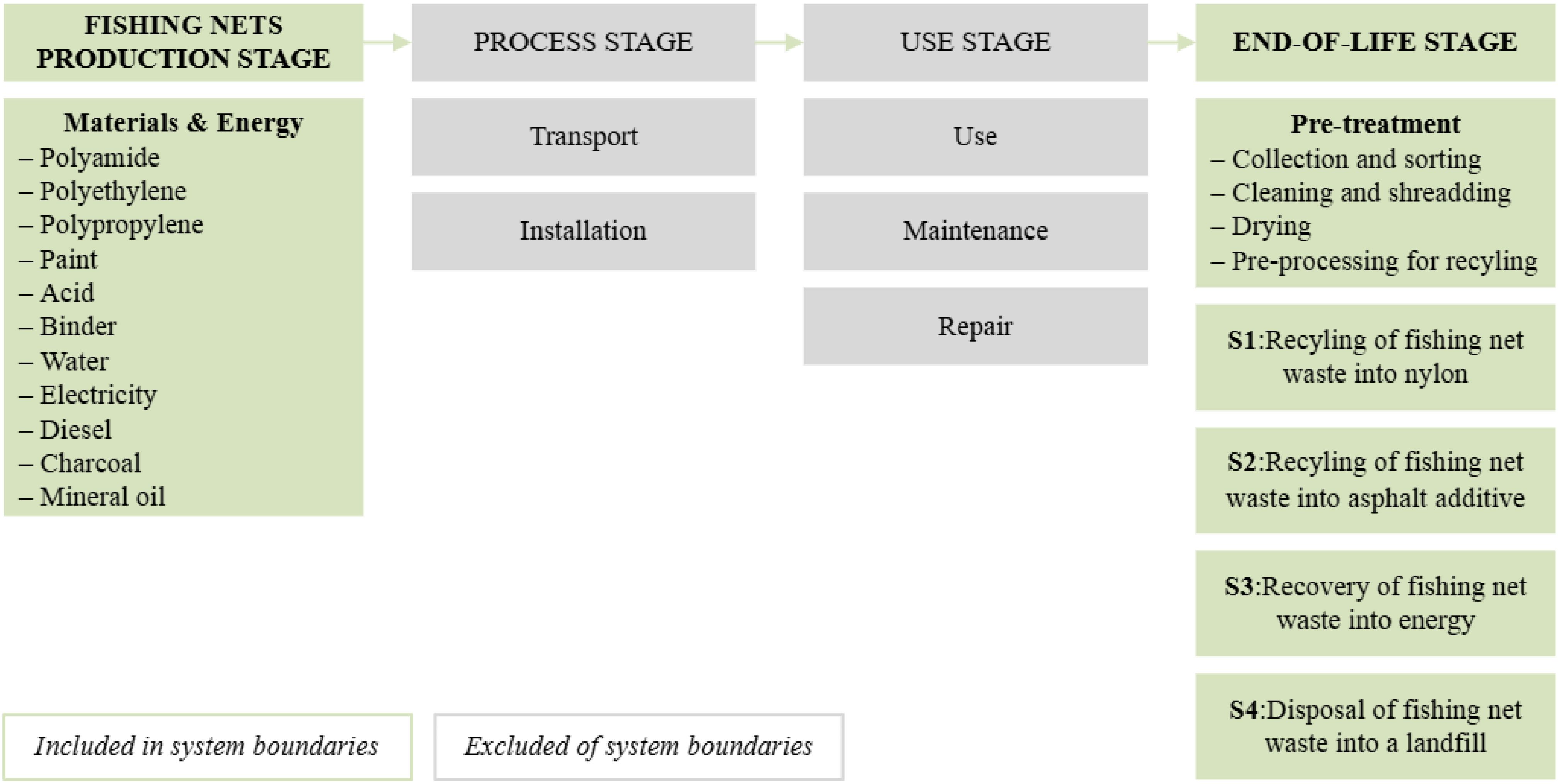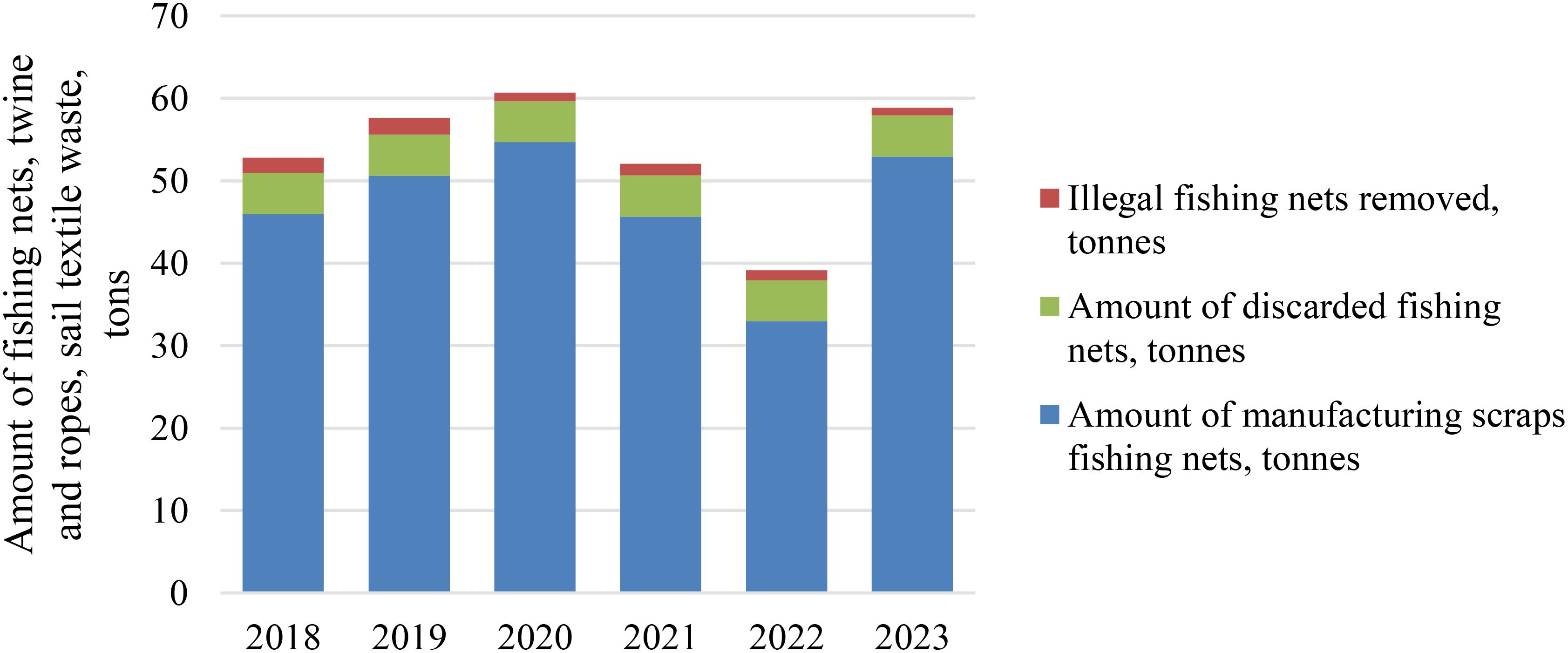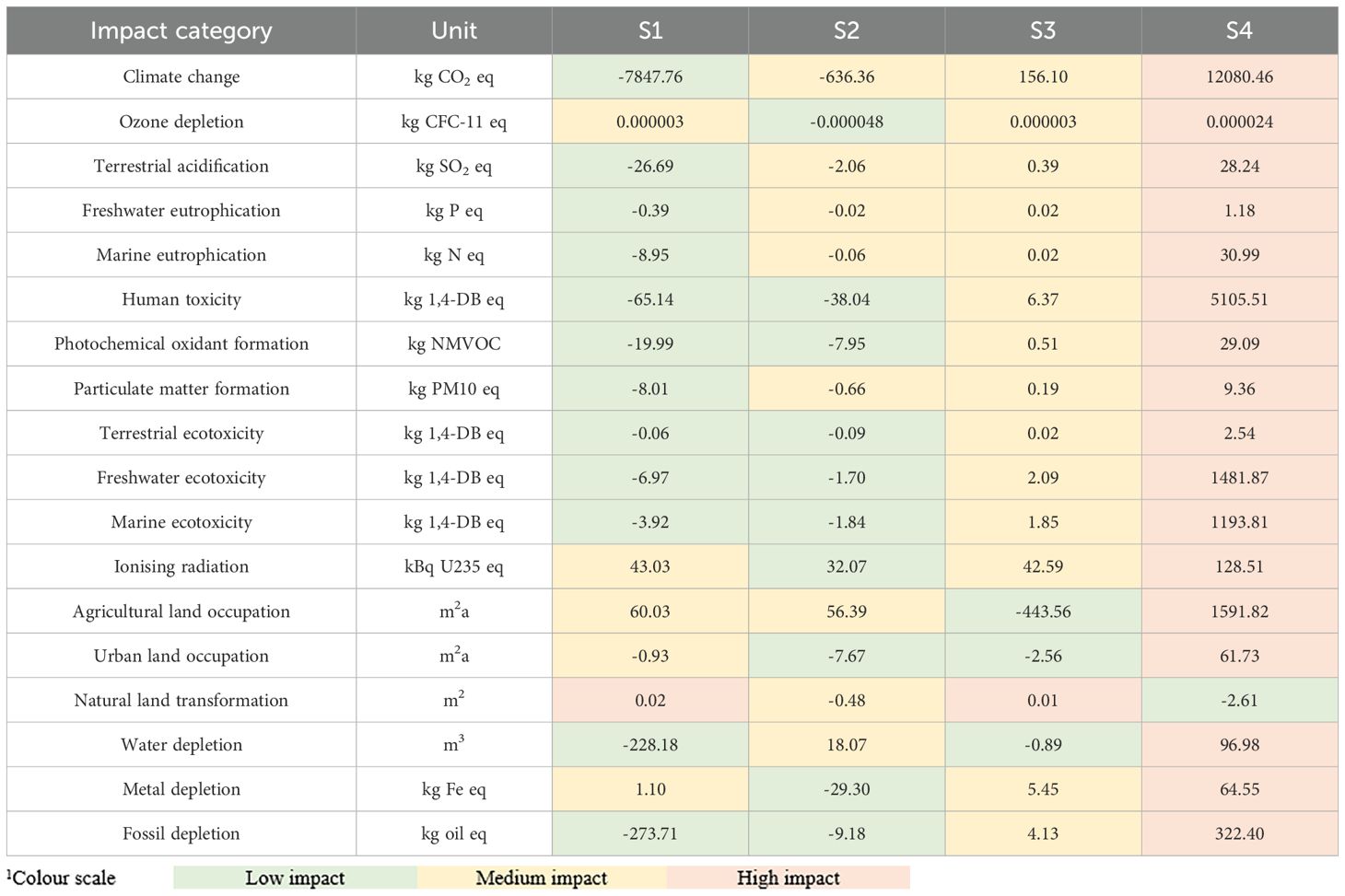- Institute of Energy Systems and Environment, Riga Technical University, Riga, Latvia
Abandoned, lost or discarded fishing gear harms marine ecosystems by releasing microplastic waste from synthetic materials, reducing biodiversity, spreading invasive species and causing long-term damage to fragile habitats. Therefore, it is essential to evaluate fishing gear waste quantities and establish efficient waste management strategies focused on reuse, recycling and recovery. This research develops a methodology to assess the quantity of discarded fishing nets and scrap waste from Latvia’s fishing gear industries, explores potential waste valorization scenarios and evaluates them based on the country-specific circular economy principles. The study employs environmental life cycle assessment (avoided burden approach) and environmental damage cost methods to evaluate different waste management scenarios for discarded fishing nets in Latvia. Findings show that manufacturing scraps exceed discarded fishing nets, with Latvia averaging 53 tons of fishing net waste annually from 2018 to 2023, and a notable drop in manufacturing during COVID-19. The assessment of valorization scenarios demonstrates that recycling fishing nets for nylon production and asphalt reinforcement significantly reduces both environmental impact and costs. Specifically, recycling for nylon production avoids 7850 kg of CO2 eq. and reduces environmental damage costs by 2947 Euro per tonne of discarded fishing nets. For asphalt reinforcement, it avoids 636 kg of CO2 eq. and results in a cost reduction of 407 Euro per tonne of discarded fishing nets. In contrast, the less environmentally feasible options, syngas production and landfilling, show higher environmental footprints. Syngas production generates 156 kg CO2 eq. per tonne of fishing nets and incurs an additional environmental damage cost of 31 Euro per tonne, but it is still a preferable alternative to landfilling. Landfilling has the most severe impact, generating 12100 kg CO2 eq. and costing 29609 Euro per tonne, making it the least favorable option and one that should be avoided. Research underscores the necessity for uniform data collection on fishing net waste and enhanced collaboration among stakeholders to facilitate valorization and investment efforts.
1 Introduction
Marine ecosystems are highly vulnerable to human pollution, which is worsening as populations and generated waste increase (Dabrowska et al., 2021). Significant form of marine pollution is abandoned, lost or discarded fishing gear (ALDFG), known as ghost gear which also includes ghost nets, which is a global transboundary plastic pollution problem (World Wide Fund, 2020; Mengo et al., 2023). At least 46% of the Great Pacific Garbage Patch consists of ghost gear and in Europe this waste is among the 10 most common types of debris found on coasts and beaches (World Wide Fund, 2020; Juan et al., 2021). Ghost nets occur under various circumstances such as when fishing nets become entangled with marine obstacles, are lost during fishing operations or interact with other fishing gear (Thomas and Lekshmi, 2017; Kozioł et al., 2022; Hodgson, 2022). The impact and longevity of ghost nets depend on their material properties, with more durable nets causing prolonged harm to marine life and ecosystems (Thomas and Lekshmi, 2017; Kozioł et al., 2022; Stephen Hodgson, 2022). Fishing nets are classified as textiles with various physical (construction, density, durability, strength and resistance) and chemical properties (composition) (Farah et al., 2021; Karadurmuş and Bilgili, 2024). The structural characteristics significant for fishing nets are summarized in Figure 1.
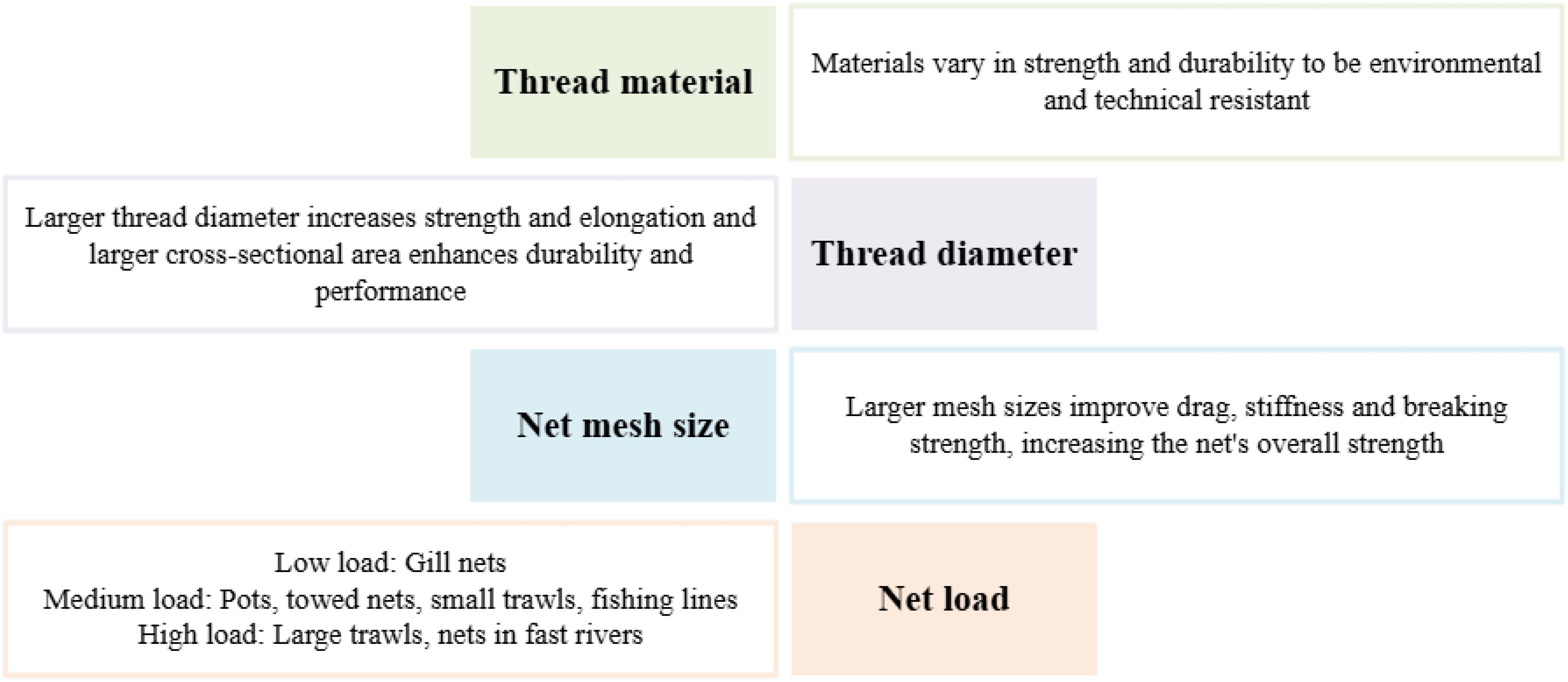
Figure 1. Fishing nets structural characteristics (Thomas and Lekshmi, 2017; Farah et al., 2021; Karadurmuş and Bilgili, 2024).
Fishing nets tend to have different composition due to the different applications and types of materials used (see Figure 2). Overall, synthetic fibers dominate, mostly polyamide, incl. nylon, in modern fishing nets due to their durability in marine environments (Karadurmuş and Bilgili, 2024).
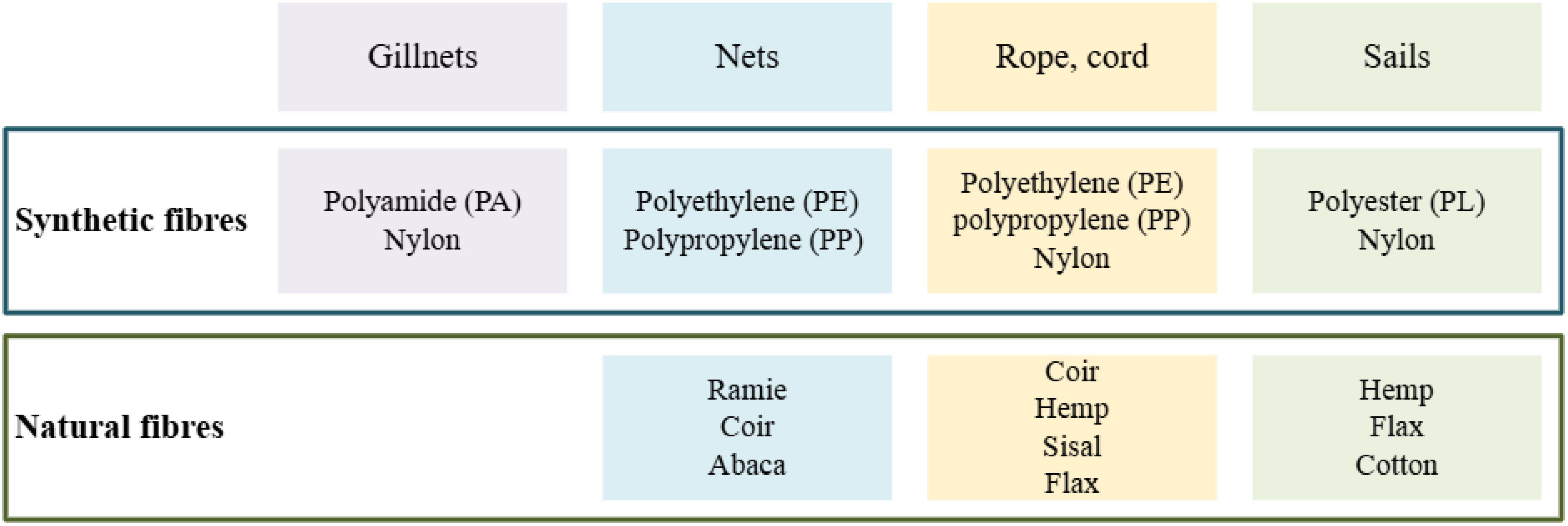
Figure 2. Synthetic and natural fibres widely used in fisheries (Singha and Singha, 2012; Thomas and Lekshmi, 2017; Sato and Shishido, 2020; Juan et al., 2021).
Synthetic fishing nets, as a type of plastic waste, causes not only environmental harm but also economic and social damage (Juan et al., 2021). The nets tend to drift freely in the initial stages and then become entangled, passively capturing and killing aquatic life, but these nets also tend to damage coral reefs and become entangled in ship propellers (Kozioł et al., 2022; Defraeye and Shoji, 2024). The research of A. R. Gajanur and Z. Jaafarresearch demonstrates that in shallow waters nets stop capturing marine organisms after 224 days, but in deeper waters, marine organisms are captured for more than three years (Gajanur and Jaafar, 2022). In additon, fishing nets impact biodiversity by introducing alien and invasive species into new areas, causing physical damage to marine habitats and animals (Gunasekaran et al., 2024). Aquatic creatures may also ingest net fragments, which can then enter the human food chain (Kozioł et al., 2022; Kannan et al., 2023). Given the significant multiplicative impact of discarded fishing nets on various enviromental issues, their proper management – through recycling, upcycling and sustainable disposal – can contribute to achieving multiple Sustainable Development Goals (SDGs), see Figure 3.

Figure 3. SDG indicators related to discarded fishing nets (United Nations Sustainable Development, 2017).
However, to achieve the SDGs related to discarded fishing nets and gear, several uncertainties must be addressed, including the amount lost, the rate of microplastic degradation and their impact on the marine environment and seafood consumers. Other challenges include the loss of fishing time due to damage or loss of gear, the effect on ecosystem services, and the unclear distribution of responsibility and financial burden for cleaning up marine debris and abandoned waters (Apete et al., 2024).
Estimates of the amount of fishing net or gear litter generated vary between studies and Table 1 some examples of data collection methods are summarized. Due to the diversity of materials, recycling of fishing nets is complicated by disassembly, high organic pollution and logistical problems, which, as a result, often lead to energy recovery from fishing nets rather than recycling, although it is technically possible (Juan et al., 2021; Basurko et al., 2023). Fishing net recycling is possible by mechanical methods, chemical methods and thermal methods, but in all the cases fishing net waste requires pre-treatment to be cleaned from organic impurities (Sala and Richardson, 2023). Then this fishing net waste is sorted and, if necessary, shredded and then processed to more valuable products (Sala and Richardson, 2023). Methods such as incineration and landfilling of fishing nets waste are unsustainable and are classified as downcycling (Kim et al., 2022). Recycled fishing nets can be reused for accessories, clothing, footwear, home furnishings and leisure goods, as well as for industrial applications such as building materials, where they help reduce early shrinkage cracking and improve the mechanical properties of cement, plaster and earth materials (Mondragon et al., 2020; Charter and Carruthers, 2022; Bertelsen et al., 2023; Sala and Richardson, 2023). Although, the industrial and large-scale use of discarded nets as a raw material for new products is hampered by the lack of reliable data and methodology on the definition of the amount of net waste generated annually.
As shown in Table 1, the primary approach to gathering information on the amount of discarded fishing nets is through interviews with fishermen, port workers and waste managers. The data collected is usually approximate and often relies on assumptions to estimate amounts. Also, no record of discarded nets is done during fishing, either on ships or in ports, which would certainly help determine a more accurate amount of discarded fishing nets.
The aim of this study is to develop a methodology to assess the amount of discarded fishing nets and manufacturing scraps, as well as to propose and assess valorization scenarios for discarded fishing nets and fishing net production scrap.
2 Methodology
This study concentrates on Latvia (Europe) and the corresponding fishing area of the Baltic Sea (refer to Figure 4). The Baltic Sea shoreline of Latvia stretches for 497 km, which constitutes roughly 0.7% of the overall coastline within the European Union. Furthermore, the inland waterways – including lakes and rivers – encompass an area of 2340 km², which accounts for approximately 3.6% of Latvia’s entire land area.
The research encompasses the years 2018 to 2023, a timeframe distinguished by two significant occurrences that profoundly impacted fishing operations. The first, the COVID-19 pandemic, and the second, Russia’s war in Ukraine, disrupted both fishing activities and the manufacturing of fishing equipment. In an effort to alleviate the repercussions of the pandemic, a sum of 2.8 million Euro in public funding was allocated across all sectors of the fishing industry (Ministry of Agriculture of the Republic of Latvia, 2022). Furthermore, an additional 5 million Euro in assistance was designated to counterbalance the ramifications of the conflict, encompassing the escalation of energy and raw material expenses, as well as the diminishment of export markets in Ukraine, Belarus and Russia (Ministry of Agriculture of the Republic of Latvia, 2022). Both occurrences also played a role in the decline of fishing net production and a reduced prevalence of discarded nets in the Baltic Sea, attributable to diminished fishing intensity and catch rates.
2.1 Quantification of discarded fishing nets
The methodology is based on three data collection approaches. The first is statistical data collection on import and export of fishing nets, the second is interviews with fishing net manufacturers and retailers, fishermen and association of fishermen, port authorities, waste management companies, national authorities (State Environmental Service, the Ministry of Agriculture of the Republic of Latvia Fisheries Department) and the third – extrapolation of missing data.
The interviews with fishermen revealed that retrieved from waters, but not ghosted, fishing nets are as long as possible repaired and reused directly for fishing or in other application, for example, farming, thus avoiding discarding. However, when nets become unusable, they are often discarded in mixed municipal waste rather than being sorted for recycling. Waste managers also confirmed that fishing nets appear irregularly in waste sorting facilities. Therefore, to enable the valorization of unusable fishing nets, a proper collection system must be developed and implemented.
Fishing nets suitable for valorization can also be sourced by retrieving ghost nets and historically lost nets from the sea. However, their quantity and material composition remain unpredictable, leading to periodic fluctuations in the availability of resources for valorization. To establish a more stable resource supply, fishing net production companies operating in Latvia could play a key role. These companies generate production scraps that are well-suited for recycling alongside discarded fishing nets, as they are made of the same material. Additionally, the quantity of these scraps is documented in company reports and remains stable, making them a reliable resource for waste recycling.
Figure 5 presents the methodology for quantifying manufacturing scraps (pre-consumption) and discarded fishing nets (post-consumption) across all material types. Combining both pre-consumption and post-consumption waste ensures a sufficient and stable supply of resources for recycling.
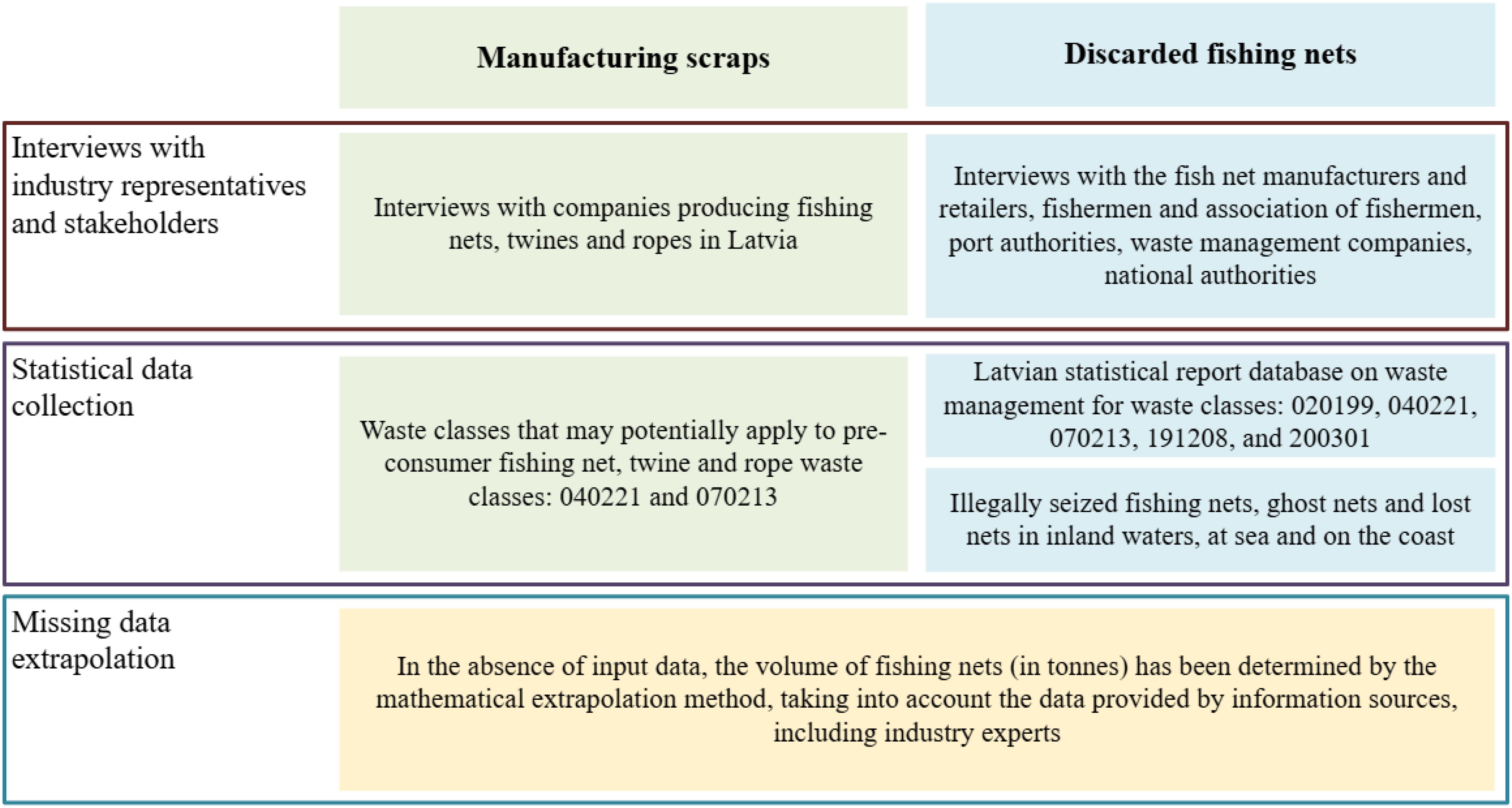
Figure 5. Methodology for quantification of manufacturing spars and discarded fishing nets. Latvian case study.
The study has certain methodological limitations, primarily related to the availability and quality of current data and assumptions made. Where data on generated and managed ALDFG waste amount was missing or incomplete, assumptions were made based on information provided by industry representatives, which may be specific to the Latvian context and not directly transferable to other regions. For example, estimates regarding the replacement frequency of fishing gear, total quantities in use in Latvia and characteristics of the most used equipment. These limitations should be considered when interpreting the findings and assessing their generalizability.
2.2 Assessment of valorization of fishing net waste
Effective waste management is necessary to prevent the environmental impact of discarded fishing nets. They can be reused and recycled through mechanical or/and chemical recycling, prioritizing recycling over landfilling (Van den Tempel and Picchioni, 2025). To assess the effectiveness of fishing net recycling, the study evaluates three valorization scenarios alongside a business-as-usual scenario – landfilling of fishing net (see Table 2). Additionally, it is important to note that only synthetic (nylon) fishing nets are analyzed in the valorization scenarios due to their predominant market presence, widespread use and significant environmental impact.
2.2.1 Environmental assessment
The principles and framework for LCA, as defined in ISO 14040:2006 and ISO 14044:2006 (International Organization for Standardization, 2006a, 2006b) are followed in this study. LCA can be used to access the impact of recycling processes through three main approaches: the cut-off approach, the partitioning approach and the avoided burden approach (Liu et al., 2022). In this research, the avoided burden approach is used to evaluate the environmental impact of different fishing nets waste management scenarios.
2.2.1.1 Goal and scope
The goal of the study is to evaluate and compare the environmental impact of discarded fishing net management scenarios. The functional unit selected for the LCA study is 1 ton of discarded fishing net after pre-treatment (i.e., after the separation of unnecessary fractions, such as organics, from the nets).
2.2.1.2 System boundary
The LCA system boundaries (see Figure 6) defined in the study are “cradle-to-cradle” (for S1-S3) and “cradle-to-grave” (for S4) and as the avoided burden approach is applied it is modelled that the discarded fishing net as a resource completely or partially replaces the traditional raw materials used in production of nylon or asphalt additive. The installation and transportation stages as well as the use phase (including maintenance, reuse, repair and replacement of fishing nets) are excluded from the assessment due to their similarity across different types of synthetic fishing nets (thus negligible) and the lack of reliable inventory data for these stages.
2.2.1.3 Inventory
Relevant inventory data, including data on fishing net production (Karadurmuş and Bilgili, 2024), fishing net waste management scenario data (Schneider et al., 2023) is obtained from literature review and "Ecoinvent” database (see Table 1 and Table 2 in Supplementary Material).
2.2.1.4 Impact assessment
The ReCiPe 2016 midpoints method has been chosen for the LCA impact assessment. The ReCiPe 2016 midpoints method has 16 impact categories, according to which the environmental impact assessment is also performed (Huijbregts et al., 2017).
2.2.2 Economic indicators
There are several methods to assess the economic aspect, such technical-economic assessment via CAPEX and OPEX (also called conventional life cycle costing), cost-benefit analysis, environmental life cycle costing and societal life cycle costing (PRé Sustainability, 2022). However, there are also environmental damage cost method, which determine the damage caused by specific pollution as euros per unit of pollutant (De Vries et al., 2024). Since environmental damage cost is not directly observable, they must be calculated based on damage assessments and economic impact studies (De Vries et al., 2024).
This study will use LCA results and convert them into monetary values Environmental damage costs are updated periodically with the latest release being from 2021 (De Vries et al., 2024). To obtain environmental prices that reflect 2025 values, an adjustment for environmental cost inflation was made using World Bank data and forecasts for 2025 (Directorate General for Economic and Financial Affairs, 2024; World Bank, 2024). The adjusted environmental damage costs by impact category are presented in Table 3.
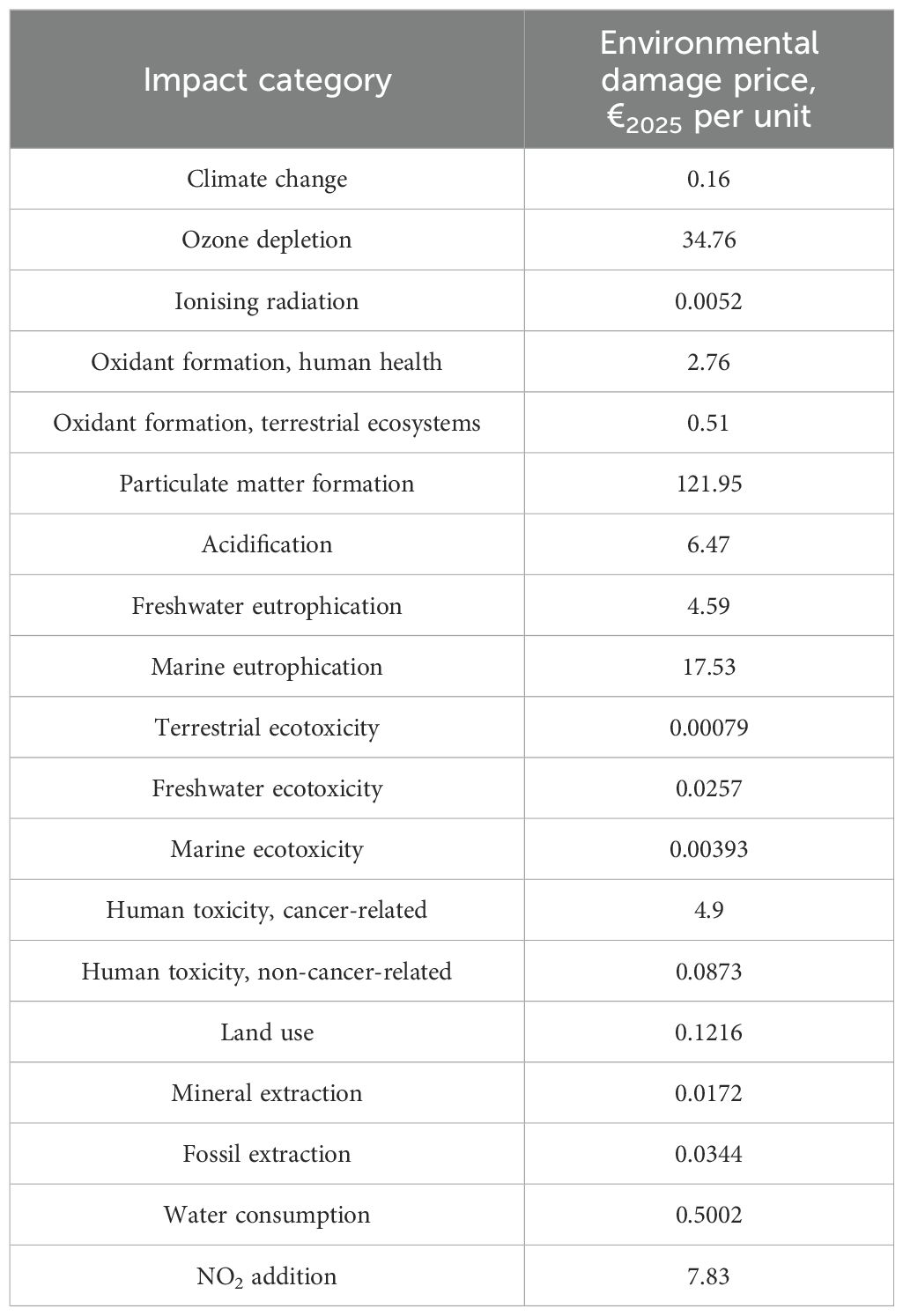
Table 3. Environmental damage costs, Euro per unit of pollutant (De Vries et al., 2024).
3 Results
3.1 Quantification of fishing nets in Latvia
In 2023, a total of 1659 illegal fishing gear was confiscated in inland waters of Latvia. The most confiscated items were fishing lines (613 pieces), followed by fishing nets (355 pieces) and crayfish traps and chalks (334 pieces). In marine and coastal waters, 121 illegal fishing gear were seized. Among these, the most frequently confiscated were fishing nets (110 pieces), along with herring nets (3 pieces), fish traps (1 piece), longline (1 piece), bream traps (3 pieces) and other type of gears (3 pieces) (Latvian Rural Consulting and Education Center, 2024). Figure 7 illustrates the amount of Latvia’s import and export fishing nets, twine, ropes and sails. As shown, these volumes fluctuate significantly from year to year, with 2022 recording the lowest export volume and the highest import volume, and on average, the import volume is twice as large as the export volume. The net domestic trade, therefore, ranges from 9 to 435 tons.

Figure 7. Annual amount of imported and exported fishing nets, twine and ropes, sails (Statistical Office of the Republic of Latvia, 2023).
Previous research (Rijkure et al., 2024), which estimated gear losses in coastal fisheries in the Baltic Sea based on national statistics and literature review, has highlighted a significant accumulation of abandoned fishing gear, particularly gillnets, entangling nets and traps, over the past 10 years. Another study quantified marine litter on the Baltic Sea floor, identifying fishing gear as a main source. This study, which involved collecting litter as part of the catch, found an average litter volume of 9.2 L/km², with polyethylene being the most common polymer (Kammann et al., 2023).
Latvian ports accept ship waste in accordance with the legislation, which includes a category for fishing gear in the corresponding form. However, this type of waste is rarely transferred at Latvian ports. It is licensed that in 2025, 42 vessels will carry out industrial fishing in the Gulf of Riga (The Ministry of Agriculture of the Republic of Latvia, 2025). For industrial fishing in inland waters, coastal waters and at sea as well as for self-consumption fishing, the fishing nets and lines with limited lengths are used. According to the regulations set up in Latvia (Cabinet of Ministers of the Republic of Latvia, 2014), the allowed annual length of inland water (lakes) fishing nets is 142–000 m, in coastal waters – over 350–000 m (Cabinet of Ministers of the Republic of Latvia, 2007, 2014). This type of data provides the maximum annual net length allowed in the national waters.
Historical data on the amount of fishing nets in national waters can only be found by cleaning up the waters. Finnish oil refining company Neste in collaboration with partners from Latvia (Latvian Maritime Academy and Science and Innovation Center of the Riga Technical University), Lithuania (Nardymo Academy) and Estonia (Teeme Ära) is working to clean up the Baltic Sea from ghost nets, develop innovative technological solutions for cleaning the sea pollution and recycling it (Neste, 2025). In the summer of 2023, a tugboat sunk during World War II was cleared near a small port town in Latvia, and within two days, 1 m3 of nylon nets, consisting of 1970s lute trawls and 40-year-old herring trawls, were brought to shore (Neste, 2023). In 2024, fishing gear with a total length of 280 m was found near a small Latvian port city lying 5–10 m deep at the sea bottom (Neste, 2024a). Industry professionals have reported numerous new shipwrecks in the Gulf of Riga, many of which are surrounded by ghost nets. Efforts to survey and map these wrecks will continue until 2026. Meanwhile, divers predict that approximately 2 tons of ghost nets will be removed, marking a significant increase compared to the previous year (Neste, 2024b) (an example of abandoned fishing gear collected from the Latvian shores of the Baltic Sea is presented in Figure 8).

Figure 8. Abandoned gear collected in Latvia (Neste, 2023).
3.2.1 Discarded fishing nets
Discarded fishing net, twine and rope waste is generated after fishing and accurate data of this type has not been yet collected for Latvia. Therefore, interviews with stakeholders were held to estimate the data. In addition, the data from the state authorities, who regularly carry out inspections in inland waters, seas and coasts and remove illegal fishing gear, was collected (see Figure 9).
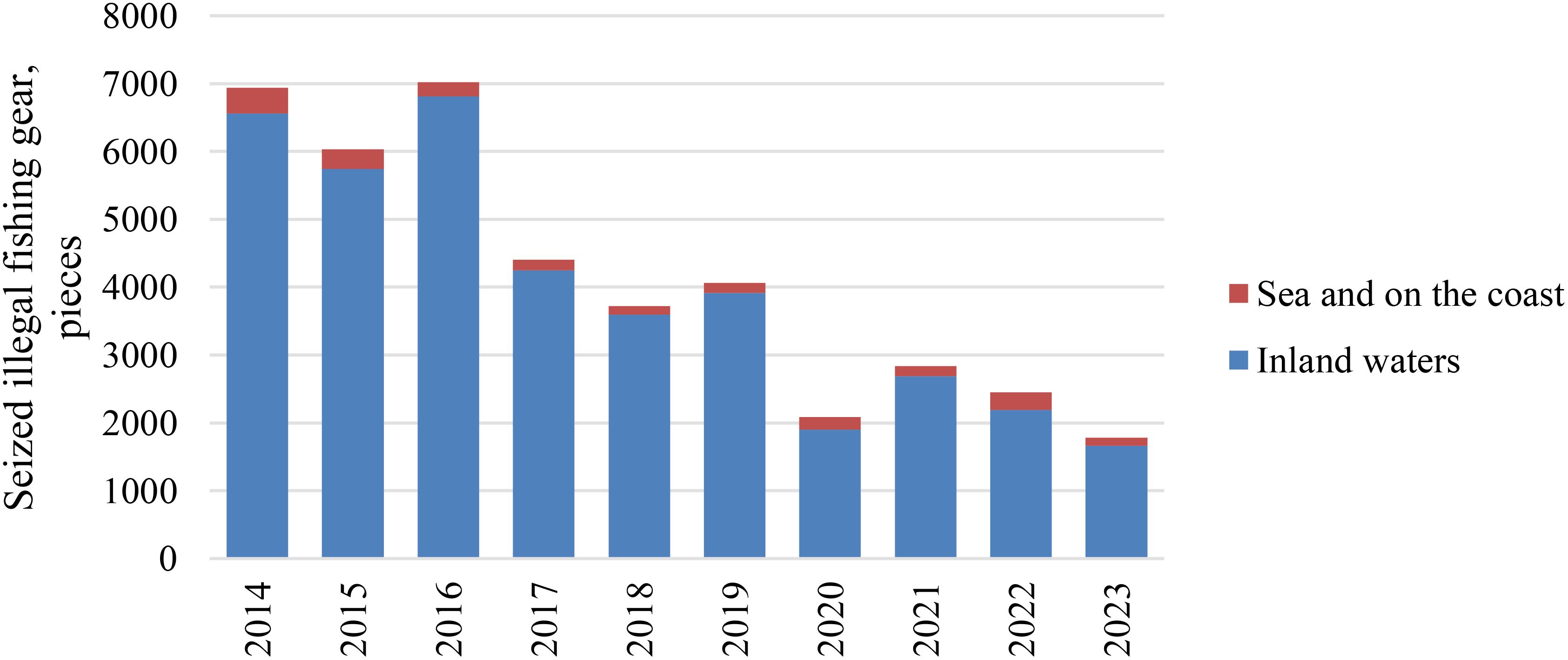
Figure 9. Illegal fishing gear seized in Latvian from 2014 to 2023 (Latvian Rural Consulting and Education Center, 2024).
Although the number of inspections in Latvia’s inland and marine waters varies from year to year, there is a slight overall trend of decline. Inspection practices are evolving through the adoption of innovative technologies such as drone surveillance, echo sounders, GPS navigation devices, thermal imaging cameras, and night vision equipment. In addition to technological advancements, administrative changes have expanded the authority to remove illegal fishing gear. This responsibility is no longer limited to inspectors from the State Environmental Service, but also includes public environmental inspectors, municipal police, municipal environmental control officers, the State Police, the State Border Guard and the Coast Guard Service of the National Armed Forces Navy. Moreover, international cooperation plays a crucial role in marine fisheries control. Inspectors from the Latvian State Environmental Service actively participate in international inspection missions. However, this cooperation was disrupted by the COVID-19 pandemic, and in 2020, Latvian inspectors took part in fewer international missions as a result.
The discarded fishing net, twine and rope waste amounts were calculated considering the volume of seized illegal fishing nets and the amount of discarded fishing nets. The following framework for the calculation is designed:
● the average weight of one net is 5 kilograms (the weight of the most used commercial fishing net).
● 40% of fishing nets are replaced once a year and 60% of fishing nets – once every 4 years.
● the total length of nets – 490–000 m annually.
● the most used fishing net type (0.17 mm nylon net, 30 m, wall height – 1.8 m, mesh size – 40 mm, weight – 0.5 kg) was used to calculate the volume of waste. Thus, the total estimated volume is 5 tonnes annually.
3.2.2 Fishing net manufacturing scraps
Latvia has companies that produce various types of fishing gear. Nylon, polyester, polyamide and polypropylene tows, cords, ropes are produced, as well as fishing threads from polyamide fibre and polyester fibre. These companies generate production scraps and residues, which are managed in accordance with regulatory enactments, and this type of waste is managed by companies in Latvia and neighbouring countries.
In Figure 10, the data about the waste generated in Latvia under the waste classes 040221 “Wastes from unprocessed textile fibres” and 070213 “Wastes from the MFSU of plastics, synthetic rubber and man-made fibres” according to the European waste catalogue (European Commission, 2000) are summarised. The average amount for 2018–2023 is 47 tons of manufacturing scrap waste.

Figure 10. Amount of manufacturing scraps fishing net, twine and rope waste, tonnes (Latvian Environmental Geology and Meteorology Centre, 2024).
3.2.3 Amount of discarded fishing nets and manufacturing scraps
Figure 11 illustrates the estimates regarding the total amount of fishing net waste, which includes both discarded fishing gear and manufacturing by-products. As depicted, the annual volume remains consistent, except for the years 2021 and 2022, when a significant decrease in fishing net waste was noted. This decline is probably associated with the effects of the COVID-19 pandemic, which disrupted the activities of fishing vessels and manufacturing firms – especially in areas heavily impacted by serious outbreaks.
Looking at the amount of manufacturing scraps and discarded fishing nets waste provides insight into the waste dynamics of the sector and the opportunity to assess waste management options. Amount of manufacturing scraps are important because they are off-cuts from the fishing net manufacturing processes and are therefore clean waste that can be subsequently recycled into a high-value product and do not require a major waste treatment step. Discarded fishing nets data are not systematically recorded and are based on estimates, but the management of this waste is also important, although the amounts in Latvia are smaller than the manufacturing scraps amount in Latvia. However, Latvia generates an average of 53 tonnes of fishing net waste that needs to be managed effectively.
3.2 Fishing net waste valorization scenarios
The results from the “ReCiPe 2016” midpoints method are reflected in Table 4. The negative values are considered as benefits to the environment and the positive values – as negative impacts to the environment.
The environmental damage costs per impact category is reflected Table 5. The most expensive environmental damage categories are particulate matter and ozone depletion. In this case, the impact of ozone depletion and particulate matter is related to electricity consumption and fishing net production. Similarly, to the LCA results, some of the environmental damage costs results are negative, thus presenting economic benefits (revenues) for the environment and society.
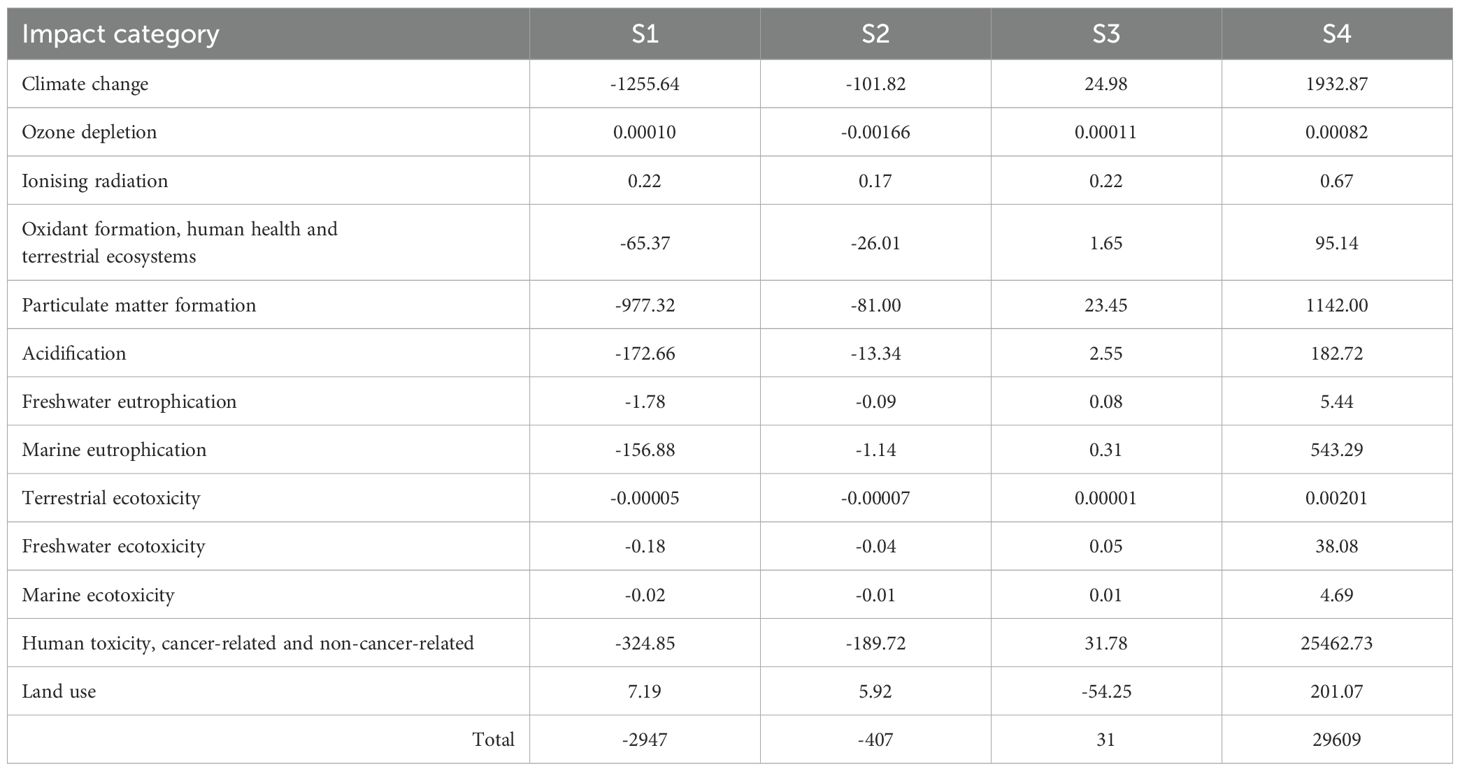
Table 5. Environmental damage costs for fishing net waste management scenarios based on 2025 monetary values.
LCA and environmental price assessment study showed significant environmental benefits from recycling fishing nets. Valorization scenario results:
● S1: replacement of new nylon with recycled fishing net waste resulted in an environmental benefit of -7–850 kg CO2 eq. and an environmental cost of -2–947 Euro.
● S2: reinforcement in asphalt materials replacing glass fibre reinforcement resulted in an environmental benefit of -636 kg CO2 eq. and an environmental cost of -407 Euro.
● S3: fishing net waste is converted into syngas resulted as a positive environmental impact of 156 kg CO2 eq. and an environmental cost of 31 Euro.
● S4: fishing nets are landfilled resulted as the highest environmental impact of 12–100 kg CO2 eq. and an environmental price of 29–609 Euro, making it the least sustainable option.
The results show the importance of avoiding landfill and instead prioritizing recycled fishing nets as replacements for new nylon (S1) and asphalt reinforcement (S2) to provide the greatest environmental benefit. Although synthesis gas production (S3) has a greater impact than S1 and S2, it is still a desirable secondary waste management option.
4 Conclusions
Abandoned, lost or otherwise discarded fishing gear becomes a serious problem in marine and coastal areas as litter and continues to passively trap aquatic organisms, affecting the environment and biodiversity. The research proposes a methodology for determining the amount of fishing nets in Latvia. It considers the number of discarded nets that is considered as post-consumer amount, as well as data from fishing net manufacturers on the amount of waste that remains from production processes and is considered as manufacturing scrap or pre-consumer waste. Valorization scenarios for discarded nets and manufacturing scrap are also examined, where an environmental performance assessment is performed for scenarios where a higher value-added product, energy, or landfilling is obtained.
The fishing industry needs to create a unified system that would monitor the amount of manufacturing scraps, as well as the number of discarded nets. To have the opportunity to use this type of waste as a resource in a circular economy. This path towards sustainability aimed on reduction and elimination of ALDFG waste should be based on involvement from multiple stakeholders. Education and awareness-raising are crucial for both the public and the fishing industry to encourage responsible gear usage and foster a greater understanding of the environmental consequences of ALDFG on marine and coastal ecosystems. This shift should also promote the use of more resilient and biodegradable materials in the production of fishing gear to mitigate long-term environmental pollution. Furthermore, targeted initiatives must concentrate on enhancing gear recovery systems and encouraging recycling practices, thereby diminishing the amount of gear waste that is deposited in landfills. To bolster these efforts, clear and comprehensive policy guidelines must be established by policymakers to guarantee effective implementation and compliance across the sector.
The creation of data passports or waste passports would also be useful. Data passports provide detailed information about a product, its raw materials and energy consumed, helping consumers make decisions with sustainability in mind, waste passports ensure proper waste management, considering materials for possible resource recycling or regeneration.
Development of symbiotic centres that would create new opportunities to use waste as a valuable resource. Promote the use of fishing nets not only in the production of decorative products but also find new and innovative solutions to obtain innovative high-value products from fishing net waste, as this will help reduce the volume of fishing nets stored in landfills and will promote the collection of these discarded fishing nets from the waters.
Data availability statement
The original contributions presented in the study are included in the article/Supplementary Material, further inquiries can be directed to the corresponding author/s.
Author contributions
BZ: Writing – original draft, Methodology, Formal Analysis, Visualization, Data curation, Conceptualization, Investigation, Writing – review & editing. JP: Writing – original draft, Data curation, Conceptualization, Validation, Writing – review & editing. JG: Writing – original draft, Conceptualization, Validation, Writing – review & editing.
Funding
The author(s) declare that financial support was received for the research and/or publication of this article. This work was supported by the EU Recovery and Resilience Facility within Project No 5.2.1.1.i.0/2/24/I/CFLA/003 “Implementation of consolidation and management changes at Riga Technical University, Liepaja University, Rezekne Academy of Technology, Latvian Maritime Academy and Liepaja Maritime College for the progress towards excellence in higher education, science and innovation” academic career doctoral grant (ID 1095).
Conflict of interest
The authors declare that the research was conducted in the absence of any commercial or financial relationships that could be construed as a potential conflict of interest.
Generative AI statement
The author(s) declare that no Generative AI was used in the creation of this manuscript.
Publisher’s note
All claims expressed in this article are solely those of the authors and do not necessarily represent those of their affiliated organizations, or those of the publisher, the editors and the reviewers. Any product that may be evaluated in this article, or claim that may be made by its manufacturer, is not guaranteed or endorsed by the publisher.
Supplementary material
The Supplementary Material for this article can be found online at: https://www.frontiersin.org/articles/10.3389/fmars.2025.1607436/full#supplementary-material
References
Apete L., Martin O. V., and Iacovidou E. (2024). Fishing plastic waste: Knowns and known unknowns. Mar. pollut. Bull. 205, 116530. doi: 10.1016/j.marpolbul.2024.116530
Basurko O. C., Markalain G., Mateo M., Peña-Rodriguez C., Mondragon G., Larruskain A., et al. (2023). End-of-life fishing gear in Spain: Quantity and recyclability. Environ. pollut. 316, 120545. doi: 10.1016/j.envpol.2022.120545
Bertelsen I. M. G., Lima A. T. M., and Ottosen L. M. (2023). “Possible Applications for Waste Fishing Nets in Construction Material,” in Marine Plastics: Innovative Solutions to Tackling Waste. Eds. Grimstad S. M. F., Ottosen L. M., and James N. A. (Springer Nature Switzerland, Cham), 211–241. doi: 10.1007/978-3-031-31058-4_12
Cabinet of Ministers of the Republic of Latvia (2007). Regulations on industrial fishing in territorial waters and economic zone waters (Latvia: Latvijas Vēstnesis).
Cabinet of Ministers of the Republic of Latvia (2014). Regulations on industrial fishing limits and the procedure for their use in inland waters (Latvia: Latvijas Vēstnesis).
Charter M. and Carruthers R. (2022). Products from Waste Fishing Nets. Available online at: www.bluecirculareconomy.eu (Accessed December 11, 2024).
Choi D., Jung S., Lee S. S., Lin K.-Y. A., Park Y.-K., and Kim H. (2021). Leveraging carbon dioxide to control the H2/CO ratio in catalytic pyrolysis of fishing net waste. Renewable Sustain. Energy Rev. 138, 110559. doi: 10.1016/j.rser.2020.110559
Dąbrowska J., Świąder M., Borowski P., Moryl A., Stodolak R., Kucharczak E., et al. (2021). Marine waste-sources, fate, risks, challenges and research needs. Int. J. Environ. Res. Public Health 18, 1–17. doi: 10.3390/ijerph18020433
Defraeye T. and Shoji K. (2024). The fishnet-harvesting buoy to collect ghost nets in the ocean: Technology concept and feasibility. Appl. Ocean Res. 150, 104062. doi: 10.1016/j.apor.2024.104062
De Vries J., et al. (2024). Environmental Prices Handbook 2024: EU27 version. Available online at: www.ce.nl (Accessed April 2, 2025).
Directorate General for Economic and Financial Affairs (2024). Economic forecast for the euro area. Available online at: https://economy-finance.ec.europa.eu/economic-surveillance-eu-economies/economic-forecast-euro-area_en?utm_source=chatgpt.com (Accessed March 17, 2025).
European Commission (2000). Commission Decision of 3 May 2000 replacing Decision 94/3/EC establishing a list of wastes pursuant to Article 1(a) of Council Directive 75/442/EEC on waste and Council Decision 94/904/EC establishing a list of hazardous waste pursuant to Article 1(4) of Council Directive 91/689/EEC on hazardous waste. Off. J. Eur. Communities. 43.
Nur F. H.S. and Siti Z. K.M.. (2021). A review on the strength of fishing net; the effect of material, yarn diameter and mesh size. Prog. Eng. Appl. Technol. 2, 1030–1036. doi: 10.30880/peat.2021.02.01.100
Gajanur A. R. and Jaafar Z. (2022). Abandoned, lost, or discarded fishing gear at urban coastlines. Mar. pollut. Bull. 175, 113341. doi: 10.1016/j.marpolbul.2022.113341
Gallagher A., Randall P., Sivyer D., Binetti U., Lokuge G., and Munas M. (2023). Abandoned, lost or otherwise discarded fishing gear (ALDFG) in Sri Lanka – A pilot study collecting baseline data. Mar. Policy 148, 105386. doi: 10.1016/j.marpol.2022.105386
Gunasekaran K., Mghili B., Bottari T., Mancuso M., and Machendiranathan M. (2024). Ghost fishing gear threatening aquatic biodiversity in India. Biol. Conserv. 291, 110514. doi: 10.1016/j.biocon.2024.110514
Hodgson S. (2022). Legal aspects of abandoned, lost or otherwise discarded fishing gear (Rome: FAO and IMO). doi: 10.4060/cb8071en
Huijbregts M. A. J., Steinmann Z. J. N., Elshout P. M. F., Stam G., Verones F., Vieira M., et al. (2017). ReCiPe2016: a harmonised life cycle impact assessment method at midpoint and endpoint level. Int. J. Life Cycle Assess. 22, 138–147. doi: 10.1007/s11367-016-1246-y
International Organization for Standardization (2006a). ISO 14040: Environmental management — Life cycle assessment — Principles and framework. (Geneva, Switzerland: International Organization for Standardization)
International Organization for Standardization (2006b). ISO 14044 Environmental management — Life cycle assessment — Requirements and guidelines. (Geneva, Switzerland: International Organization for Standardization)
Juan R., Domínguez C., Robledo N., Paredes B., Galera S., and García-Muñoz R. A. (2021). Challenges and opportunities for recycled polyethylene fishing nets: towards a circular economy. Polymers 13. doi: 10.3390/polym13183155
Kammann U., Nogueira P., Wilhelm E., Int-Veen I., Aust M.-O., Wysujack K., et al. (2023). Abandoned, lost or otherwise discarded fishing gear (ALDFG) as part of marine litter at the seafloor of the Baltic Sea – Characterization, quantification, polymer composition and possible impact. Mar. pollut. Bull. 194, 115348. doi: 10.1016/j.marpolbul.2023.115348
Kannan G., Mghili B., Di Martino E., Sanchez-Vidal A., and Figuerola B. (2023). Increasing risk of invasions by organisms on marine debris in the Southeast coast of India. Mar. pollut. Bull. 195, 115469. doi: 10.1016/j.marpolbul.2023.115469
Karadurmuş U. and Bilgili L. (2024). Environmental impacts of synthetic fishing nets from manufacturing to disposal: A case study of Türkiye in life cycle perspective. Mar. pollut. Bull. 198, 115889. doi: 10.1016/j.marpolbul.2023.115889
Kim S., Kim Y. T., Oh L. S., Kim H. J., and Lee J. (2022). Marine waste upcycling—recovery of nylon monomers from fishing net waste using seashell waste-derived catalysts in a CO2-mediated thermocatalytic process. J. Mater. Chem. A 10, 20024–20034. doi: 10.1039/D2TA02060B
Kozioł A., Paso K. G., and Kuciel S. (2022). Properties and recyclability of abandoned fishing net-based plastic debris. Catalysts 12. doi: 10.3390/catal12090948
Latvian Environmental Geology and Meteorology Centre. (2024). Form No. 3 – Waste. Waste report. Waste report by production facility 2018–2023 year. Available online at: https://videscentrs.lvgmc.lv/lapas/parskatu-ievadisana (Accessed January 8, 2025).
Latvian Rural Consulting and Education Center (2024). Latvian Fisheries Yearbook 2024. (Jelgava: Jelgavas tipografija Ltd).
Liu J., Daigo I., Panasiuk D., Dunuwila P., Hamada K., and Hoshino T. (2022). Impact of recycling effect in comparative life cycle assessment for materials selection - A case study of light-weighting vehicles. J. Cleaner Production 349, 131317. doi: 10.1016/j.jclepro.2022.131317
Mengo E., Randall P., Larsonneur S., Burton A., Hegron L., Grilli G., et al. (2023). Fishers views and experiences on abandoned, lost or otherwise discarded fishing gear and end-of-life gear in England and France. Mar. pollut. Bull. 194, 115372. doi: 10.1016/j.marpolbul.2023.115372
Ministry of Agriculture of the Republic of Latvia (2022). Minister for Agriculture K. Gerhards promotes the development of the fisheries sector. Available online at: https://www.zm.gov.lv/lv/jaunums/zemkopibas-ministra-k-gerharda-vadiba-sekmeta-zivsaimniecibas-nozares-attistiba (Accessed December 4, 2024).
Mondragon G., Kortaberria G., Mendiburu E., González N., Arbelaiz A., and Peña-Rodriguez C. (2020). Thermomechanical recycling of polyamide 6 from fishing nets waste. J. Appl. Polymer. Sci. 137. doi: 10.1002/app.48442
Neste (2023). Ghost nets pulled from the Baltic Sea in Engure. Available online at: https://www.neste.lv/lv/engure-no-baltijas-juras-izcelti-spoku-tikli (Accessed March 4, 2025).
Neste (2024a). Ghost nets pulled from the Baltic Sea in Engure. Available online at: https://www.neste.lv/lv/engure-no-baltijas-juras-izcelti-spoku-tiklii (Accessed March 4, 2025).
Neste (2024b). Neste will continue to clean the Baltic Sea from ghost nets this summer. Available online at: https://www.neste.lv/lv/neste-šovasar-turpina-attīrīt-baltijas-jūru-no-spoku-tīkliem (Accessed March 4, 2025).
Neste (2025). Invisible pollutants – ghost nets. Available online at: https://www.neste.lv/lv/neredzamie-piesarnotaji-spoku-tikli (Accessed March 4, 2025).
PRé Sustainability (2022). guide to life cycle costing. Available online at: https://pre-sustainability.com/articles/life-cycle-costing-in-more-detail/ (Accessed January 24, 2024).
Richardson K., Hardesty B. D., and Wilcox C. (2019). Estimates of fishing gear loss rates at a global scale: A literature review and meta-analysis. Fish Fisheries 20, 1218–1231. doi: 10.1111/faf.12407
Rijkure A., Cerbule K., and Megnis J. (2024). Abandoned, lost, or otherwise discarded fishing gear in coastal fisheries: A case study in the Baltic Sea coastal waters of Latvia. Mar. Policy 165, 106187. doi: 10.1016/j.marpol.2024.106187
Sala A. and Richardson K. (2023). Fishing gear recycling technologies and practices. (Rome: FAO and IMO). doi: 10.4060/cc8317en
Sato T. and Shishido M. (2020). Mechanical and structural properties for recycled thermoplastics from waste fishing ropes. J. Material Cycles Waste Manage. 22, 1682–1689. doi: 10.1007/s10163-020-01062-x
Schneider F., Parsons S., Clift S., Stolte A., Krüger M., and McManus M. (2023). Life cycle assessment (LCA) on waste management options for derelict fishing gear. Int. J. Life Cycle Assess. 28, 274–290. doi: 10.1007/s11367-022-02132-y
Singha M. and Singha K. (2012). Applications of textiles in marine products. Mar. Sci. 2, 110–119. doi: 10.5923/j.ms.20120206.01
Statistical Office of the Republic of Latvia (2023). Trade and services - Foreign trade in goods (import, export) - Exports and imports by goods (CN) and country ATD080. Exports and imports by countries, groups of countries and territories (CN in 8 digits) 2005 - 2023. Available online at: https://stat.gov.lv/lv/statistikas-temas/tirdznieciba-pakalpojumi/areja-tirdznieciba (Accessed January 8, 2025).
The Ministry of Agriculture of the Republic of Latvia (2025). Fishing sector. Available online at: https://www.zm.gov.lv/en/fisheries (Accessed March 14, 2025).
Thomas S. N. and Lekshmi M. N. (2017). Recent trends in fishing gear materials. Available online at: https://krishi.icar.gov.in/jspui/bitstream/123456789/25144/1/03_Recent%20trends.pdf (Accessed December 1, 2023).
Tonsi G., Maesani C., Alini S., Ortenzi M. A., and Pirola C. (2023). Nylon recycling processes: a brief overview. Chem. Eng. Trans. 100, 727–732. doi: 10.3303/CET23100122
United Nations Sustainable Development (2017). 17 Sustainable Development Goals. Available online at: https://sdgs.un.org/goals (Accessed February 3, 2025).
Unsbo H., Boltenstern M., and Olshammar M. (2023). Quantification and environmental pollution aspects of lost fishing gear in the Baltic countries. Available online at: www.ivl.se (Accessed January 10, 2025).
Unsbo H., et al. (2022). Quantification and environmental pollution aspects of lost fishing gear in the Nordic countries Funded by: Nordic Council of Ministers. Available online at: www.ivl.se (Accessed January 10, 2025).
Van den Tempel P. and Picchioni F. (2025). Polymer recycling: A comprehensive overview and future outlook. Recycling 10. doi: 10.3390/recycling10010001
World Bank (2024). A Global Database of Inflation. Available online at: https://www.worldbank.org/en/research/brief/inflation-database (Accessed March 17, 2025).
World Wide Fund (2020). Stop Ghost Gear: The most deadly form of marine plastic debris. Available online at: www.panda.org (Accessed January 20, 2025).
Keywords: ghost nets, ALDFG, marine litter, recovery, life cycle analysis, environmental damage prices, SDG, data acquisition
Citation: Zlaugotne B, Pubule J and Gusca J (2025) Fishing net waste management: quantification and valorization. Front. Mar. Sci. 12:1607436. doi: 10.3389/fmars.2025.1607436
Received: 07 April 2025; Accepted: 22 May 2025;
Published: 18 June 2025.
Edited by:
Teresa Bottari, National Research Council (CNR), ItalyReviewed by:
Gunasekaran Kannan, Chulalongkorn University, ThailandMustapha Aksissou, Abdelmalek Essaadi University, Morocco
Copyright © 2025 Zlaugotne, Pubule and Gusca. This is an open-access article distributed under the terms of the Creative Commons Attribution License (CC BY). The use, distribution or reproduction in other forums is permitted, provided the original author(s) and the copyright owner(s) are credited and that the original publication in this journal is cited, in accordance with accepted academic practice. No use, distribution or reproduction is permitted which does not comply with these terms.
*Correspondence: Beate Zlaugotne, YmVhdGUuemxhdWdvdG5lQHJ0dS5sdg==
 Beate Zlaugotne
Beate Zlaugotne Jelena Pubule
Jelena Pubule Julija Gusca
Julija Gusca